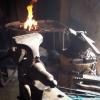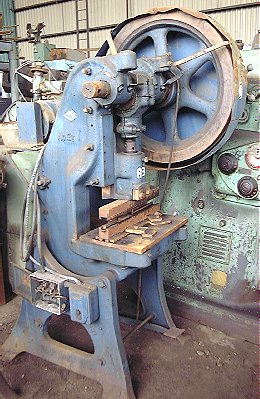-
Posts
158 -
Joined
-
Last visited
Contact Methods
-
Website URL
sandersoniron.com
Profile Information
-
Gender
Male
-
Location
Southern Michigan, near the border
-
Interests
forging, obviously
Recent Profile Visitors
3,283 profile views
-
Well, that is true, but I really like old machines and was wondering what else is out there from the old school that would be less annoying. You have a good point, but there's no way for me to make an old machine--just can't be done. That's my good point. Okay guys! So I had a frustrating day with a machine that annoyed me. Anyone else ever have a day like that? All in fun, fellas.
-
Now Jim, that STS of yours is something to think about! It bends on the vertical, which I'd bet has some advantages keeping things in line. I like it. It looks nice and rigid too, and by bending vertically, it has the floor to back it up. Hmmmm... I thought I'd be back up in your woods long before this. Seems like I get busier in the spring than I remember in the winter, and then I'm behind all summer. I use the bender for general bending and straightening cold up to, oh, 1/2" by 2" and hot on up to 2" round. I'd much rather straighten under the hammer, of course, especially taking a lateral curve out of a bend which is supposed to be on a planarity. The thing that bothers me about the Hossfeld is all the flex in it. It's pretty much impossible to form a nice slow curve in flat stock and not have it become a slow spiral. On my tables' frames, that's a problem, of course. I'm making a demilune frame now for a console. I make a template, carefully bend the iron to the line with the Hossfeld, then I have to go over to the vise, take the twist out of it, which ruins the bend of course; so it's back and forth, back and forth. If the Hossfeld were made of more meat (like Jim's bender!) its frame wouldn't twist, and it'd do better work. I'd like to see a "scrolling pin bender" which you mention. Sounds interesting. For repeated bends I use the shaper. That's consistency, but it doesn't allow free-forming and general bending.
-
Has anyone seen an antique bender like--or better yet not like--a Hossfeld? Are there any old quality versions that are made stiffer and better and make their users smile instead of cuss? Old machinery makes smiles happen in my world. I cannot stand a Hossfeld, but I have to have the darn thing because there're some things only it can do. But dagonne, that's a poorly made, boingy, annoying thing! Mine's a No. 2, and I bought it new, so it's in as good a shape as ever was intended (as if "good" can apply to one at all). Ugh. This is why I bend with a shaper or under a hammer as much as possible. Gee, this is sounding like one of my air hammer rants. No offense to you loyal Hossfeld people, if any exist. Joel
-
Ha ha! Yes! I guess I'm the other way around. I drive a horse to work daily, and my wife doesn't like it when I drive a car because I forget that without a horse I have to look where I'm going! That can be a problem. When you get your press, make certain you know its rated speed. Don't trust the pulley/motor that comes with it to figure that out. Then run it slower at first until you get used to it. If you mess up then, it'll be no big deal. I ran mine at 60 RPM for awhile, then sped it up to 100 later. Look for one with a hole-thru table. Mine is solid, and it's a handicap; a hole lets you do more, and not just punch. That hole can be used for a drop-in sub press or shoe, and those often have built in springs for cushion and extended die contact (memory issue). Don't think in black and white and absolutes, and you'll be a lot more successful with it. A press can do about anything. Yes, but you see, hot iron is their normal use, just not their common use. These things go back nearly to the beginning of industry and are seen in old photographs alongside hammers. This is not my idea, you know. By the way, that anchor's a really nice bit of drifting.
-
Is it okay to take Michael's post and hijack it to a general discussion like this? I feel like we should focus on the guy's question; but maybe by reading what we have to say, he'll get something out of this. I hope? Not sure who's right and who's wrong here anymore. Ha ha! But I am going to make the following statement and then clarify it: A punch press can do anything a power hammer can do--anything. --Joel Sanderson, April 23, 2018 Some operations that are difficult with a hammer are a breeze with a press, and some operations that are a breeze with a hammer are difficult with a press. The two machines compliment each other very well that way. Have you punched many holes with your hammer? (punched--not drifted) That's a lot easier with a press. Slot punching round bars? Piece of cake with a press--centered. Heading? Riveting? Easier and more consistant with a press. Starting a tendon? One tool no matter the stock size. The list goes on and on. A hammer can do about anything, right? but not everything is best done with it. Same with a press. Forging tapers with a press require more complicated tooling than with a hammer, but it can be done. Swaging is not ideal with a press either, since it's slow and has more die time. So... Either can do what the other does, but neither is always the best machine for the job. Does this make sense? I'm not sure why you'd insist on not adjusting the press. You wouldn't even want to do that with a 50 pound Little Giant--and maybe not a 100 pounder, though I've never run one. A press is a different machine. Don't treat it like a hammer, or you'll be very disappointed.
-
I'm irresponsible? This is hysterical. I just gotta ask, have you ever forged with a punch press, Exo313?
-
I would say Thomas and Frosty did challenge my statement that a punch press can do anything a hammer can do--with exclamation points to boot. (I didn't take yours that way though.) Over and over we hear the claim that punch presses are worthless to blacksmiths, and that holds our craft back--holds people like Michael back--because they have great potential at a very low cost.
-
Measure. Run it the speed intended. The flywheel has only so much energy (if you run it the correct speed) and the frame and crank are engineered to withstand that energy, probably by at least a factor of 3. You can stop a press (and I have), but it's more of a headache than a nightmare. Sometimes it jams; sometimes it bounces back; but I try to avoid the problem in the first place by using it sensibly. You can do things to kill a hammer too, and they also can be dangerous machines, but those are no reasons to keep us from using them. There're lots of welded hammers out there. Two of my hammers have had major repairs--welded or brazed parts that broke under the machine's own power. Does that mean power hammers are no good because they self destruct?
-
Frosty, do you have a punch press in your shop? I'm gonna guess no, just like I'm gonna guess (by his silence) that Thomas doesn't have one either. So here we have two people who don't have a punch press and probably have never used one for open die forging announcing that it can't be done. Yet, I've been using one for just that for almost twenty years. (I still haven't seen it explode.) Videos are hardly my shop's focus, but I have a few. You're free to look at them any time you want; and while you're at it, take a peak at my work. Everything leaves tracks, and my press has left lots of happy little tracks all over my iron. Michael, if you're looking for a machine to make damascus, a punch press will do each operation: weld, draw, cut for folding (and fold if you want to), weld again, repeat. Like I said, a press can do anything a hammer can do. I don't make damascus anymore, but from my experience with both that and a press, I'm gonna say that you probably would get better consistency with a press than with a hammer or similar percussion or manual stroke machine. And the cost is right smack-dab in the I-can-afford-to-experiment zone; and maybe even the I-can-have-more-than-one zone. Feel free to get ahold of me with questions. I don't want to get into a shouting match on a public forum with well meaning people who haven't done this. (edit off site link) a video will probably show up there eventually. Just search for my name and business. Best of luck in your decision. Joel Sanderson You incorrectly assume that because he has not been online to read and argue your posts that you are correct? that is a flawed premise
-
Thomas, do you have an OBI in your shop? Any kind of punch press?
-
A punch press, (toggle press, O.B.I) will do anything a hammer will do, no modification whatsoever, and you can get em for scrap or less around here. Don't know about Washington. Go for between 35 to 75 tons. I've stuck on a picture down below of a random OBI just so you know what I'm talking about.
-

Protective cover for bottom die
Sanderson Iron replied to beaudry's topic in Power Hammers, Treadle Hammers, Olivers
I don't know if this will help at all, but at least it's information. I looked up what I made the dies out of for my 100 pounder: one is H13; the other is 4340. They are 3 1/2" wide and 8" long. The H13 die is a bolster die and is heat treated to RC 50. I think that was all the harder it could be made. The plain flat die is hardened to between RC 50 and 55. They both have dents in them though. I think your plate's an excellent solution. I might do that myself. Thanks. -

Protective cover for bottom die
Sanderson Iron replied to beaudry's topic in Power Hammers, Treadle Hammers, Olivers
I'd take them someplace to be Rockwell tested. I wonder if they're hard enough if you're able to file them. If they're under C50, send them somewhere to be heat treated. I'll try to remember to look in my records today to find out how hard the 4140 bottom die on my 100 pounder is. However, I've had the same issue with my 250's die when it's had a swage in one place awhile. That die came on the hammer, so I have no idea what it is. My swages are 5160 if that matters at all. That's because it's a variable speed, variable stroke length, come-with-a-brake for instant stopping Beaudry. Beaudry guys all know their hammers are the best in the universe too. (Not just the known universe, but the whole entire thing.) I'd like to have one, but I already know my hammer's the best in two universes, both of which are unknown. -

Protective cover for bottom die
Sanderson Iron replied to beaudry's topic in Power Hammers, Treadle Hammers, Olivers
Yes, I've had it happen, but it took a very long time with the same set-up to be noticeable on the die. Mostly it's the bottom of the swage that pits. Are you making your swages? Are they annealed? What is your bottom die made of, and is it heat treated to RC 55 at least? I like your solution. Thanks for sharing. Tsk tsk. Shows how small your universe is. (A one speed hammer. Sheesh!) -

Best drill bits for 5160 steel.
Sanderson Iron replied to ZachNiedjalski's topic in Drills, Post drills, Mag drills, etc
A pilot hole will help a lot if you can get your speeds right. Don't know what you're working with.



